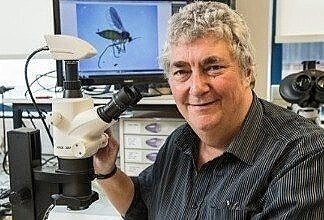
Flower Crab Spiders: Predators of Pollinators Hiding in Plain Sight
Britain’s private gardens can provide ideal habitats for many of Britain’s native wildlife, whether it’s living within the garden or just passing through, simply by being chemical-free, growing as many plants as possible and having a source of freshwater. By becoming wildlife-friendly, the garden will not only enable us to observe many wonders of the natural world in close quarters, but it’ll be contributing to the nationwide quest to restore Britain’s declining biodiversity.
Since gardens that attract wildlife enable natural food chains to establish, where everything from the plants and the animals that feed on them, to their predators and parasites, will be playing a role in sustaining the health of the ecosystem. This is particularly so with invertebrates, most of whom reside within the lower levels of the food chains, where many are what we refer to as the keystone species - the species that when they are lost from an ecosystem can often lead to its demise.
Surviving at the bottom of the food chain will however be fraught with danger where the interactions between predators and prey will be intense. Interactions that over millions of years have resulted in a diverse array of survival techniques and weapons for both defence and attack.
Many of the techniques that the different species of invertebrates use to survive will be occurring within wildlife-rich gardens throughout most of the year. One that can often be seen in action amongst the summer flowering plants is the hunting technique of the Flower Crab Spider.
Most pollinators will have relatively good eyesight though and can avoid the flowers that host a spider if they can see it. However, Crab spiders have evolved the ability to identify the colour of a flower and, so long as it’s pale green, yellow, pink or white, they’ll change the colour of their body to match it, enabling them to be perfectly camouflaged on a flower as they wait for their prey to arrive.
Then, as their victim lands, they’ll snap their legs shut around it and inject paralysing venom through long slender fangs. And whilst their hapless victim might still appear to be feeding on the flower, underneath it the crab spider will be draining it of life.
But despite the remarkable predatory skills of the Flower Crab Spiders, they are not aggressive spiders and are no threat to us. However, for the benefit of the arachnophobes amongst us, it might be worth taking a closer look at the flowers in the garden before picking them.
Since gardens that attract wildlife enable natural food chains to establish, where everything from the plants and the animals that feed on them, to their predators and parasites, will be playing a role in sustaining the health of the ecosystem. This is particularly so with invertebrates, most of whom reside within the lower levels of the food chains, where many are what we refer to as the keystone species - the species that when they are lost from an ecosystem can often lead to its demise.
Surviving at the bottom of the food chain will however be fraught with danger where the interactions between predators and prey will be intense. Interactions that over millions of years have resulted in a diverse array of survival techniques and weapons for both defence and attack.
Many of the techniques that the different species of invertebrates use to survive will be occurring within wildlife-rich gardens throughout most of the year. One that can often be seen in action amongst the summer flowering plants is the hunting technique of the Flower Crab Spider.
What is the Flower Crab Spider?
A spider that doesn’t spin webs, but instead uses an ambush technique to catch its prey, which is primarily the nectar-feeding insects, such as butterflies, bees and hoverflies. Flower Crab spiders are easily recognised by their crab-like shape and their ability to walk backwards and sideways. Their two pairs of front legs are also longer and stronger than their other legs and are held wide open whilst the spider remains motionless, on or within the corolla of a flower waiting for its prey to arrive.Most pollinators will have relatively good eyesight though and can avoid the flowers that host a spider if they can see it. However, Crab spiders have evolved the ability to identify the colour of a flower and, so long as it’s pale green, yellow, pink or white, they’ll change the colour of their body to match it, enabling them to be perfectly camouflaged on a flower as they wait for their prey to arrive.
Then, as their victim lands, they’ll snap their legs shut around it and inject paralysing venom through long slender fangs. And whilst their hapless victim might still appear to be feeding on the flower, underneath it the crab spider will be draining it of life.
But despite the remarkable predatory skills of the Flower Crab Spiders, they are not aggressive spiders and are no threat to us. However, for the benefit of the arachnophobes amongst us, it might be worth taking a closer look at the flowers in the garden before picking them.

About Dr Ian Bedford
Ian has been fascinated by the bug world for as long as he can remember. From studying butterflies on the South Downs as a youngster, he went on to pursue a career in Research Entomology and ran the Entomology Dept at the John Innes Centre in Norwich up until his recent retirement.VISIT WEBSITE

'Bug of the month'
Visit our 'bug of the month' archive.
Every month Ian will share his knowledge on how to protect your plants and gardens from preventable pest invasions while providing valuable insights into the insects regularly found in our gardens.
find out more
Comments (0)
Why not be the first to send us your thoughts?
